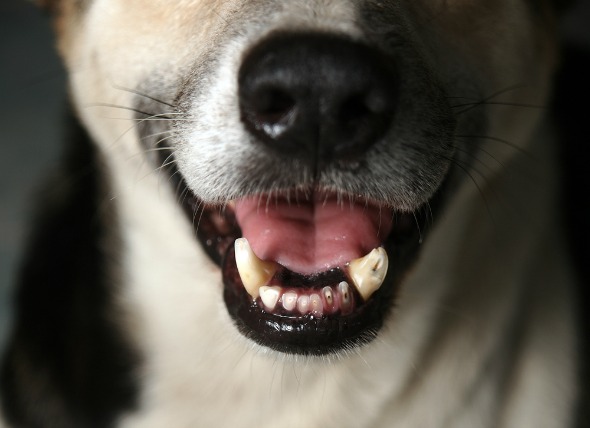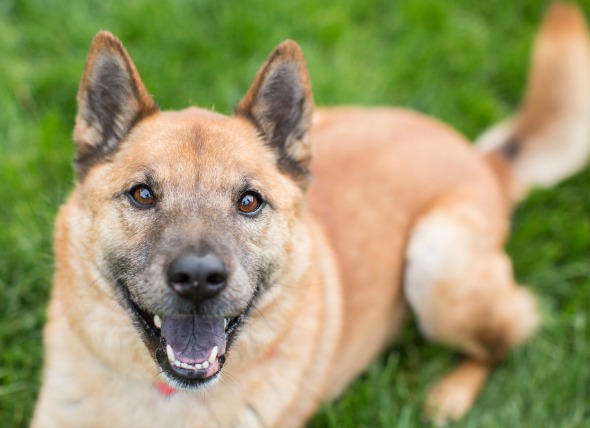

While we generally never give our appliances a second thought, they can be very dangerous for playful and inquisitive young dogs. Electrocution from chewing on an electrical cord is the single most common type of electrical injury for household pets. These types of injuries can result in burns to the surrounding areas (e.g., mouth, hair), or because the current alters the electrical conduction in the heart, muscles, and other tissues. Possible complications of electric cord bite injuries are fluid accumulation in the lungs (pulmonary edema) and high blood pressure in the arteries near the lungs (pulmonary hypertension). Additionally, there have been reports of animals developing cataracts – an eye abnormality - after such injuries.
The most obvious sign of an electrical injury is burns in or around your dog's mouth. If either the whiskers or the hair surrounding the mouth are singed, this can be an indication that your dog has been burned at some point. The majority of serious symtoms are related to your dog's breathing, shortness of breath being the most common. Non-respiratory indicators are rapid heart rate (tachycardia), muscle tremors, seizures, and physical collapse.Some of the most common signs of serious electrical injury are:
Most injuries of this type are seen in animals younger than two years old. Whether it is because of teething, with the urge to chew as new teeth grow in, or because your puppy has a natural tendency to chew on things, it is during these younger years that injury due to biting into an electrical cord is most likely to happen.
Your veterinarian will perform a thorough physical exam on your dog, taking into account the background history of symptoms and possible incidents that might have precipitated this condition.
The symptoms listed above can be due to an electrical cord injury, but there are other possibilities as well. Issues in the heart, such as an irregular heart rate, could be due to an existing heart disease. Electrocardiogram (ECG, or EKG) recording can be used to examine the electrical currents in the heart muscles, and may reveal any abnormalities in cardiac electrical conduction (which underlies the heart’s ability to contract/beat). This will enable your veterinarian to confirm or rule out heart disease. Heart problems can also occur if your dog has ingested rodent poison. The poison used to kill rodents contains anticoagulants which block the production of vitamin K -- necessary for the clotting agents found in the blood to work normally. This possibility can be ruled out through blood coagulation testing.
Generally with electrical cord injuries the lungs are filled with a pink, foamy fluid. There are often tan or gray wounds in the mouth, and areas with red spots inside the heart lining.
If you are a witness to the electrocution, make sure you turn off the electricity before moving uour dog. If your dog has lost consciousness, clear its airway as best as you can, and if necessary, provide breathing assistance and/or oxygen.
If your dog is suffering from a decreased blood or platelet supply, it will need to be treated intravenously with special fluids (crystalloids or colloids). Fluid in the lungs can be treated with diuretics (furosemide). Therapy for irregular heart rhythm may be necessary as well. Your doctor will perform various tests prior to releasing your dog into home care. Sufficient medical care can normally be performed within a day, but it may take longer if complications occur. In the case of burns, your veterinarian will consult with you on the best course of action.
If your dog has been injured, it will need to be closely monitored until its condition stabilizes. Your dog may not feel comfortable eating its regular food because of the pain associated with wounds in the mouth. Using soft foods, or liquefying foods for your dog to eat until the wounds have healed will ensure that your dog does not become malnourished. Your veterinarian can help you to make a diet plan until your dog can comfortably eat regular food again.
At home, monitor the burn wounds for infection. Another possible complication of a mouth injury is the development of an opening between the inside of your dog's mouth and nose, requiring surgical repair.
The most important step in preventing electrical injury is to keep your dog away from electrical cords and outlets. Additionally, inspect all cords in your home and throw out any that are damaged, since even minimal contact with a bare wire can cause serious harm to your dog (making contact with the feet, nose, or tongue, for example). Using baby-proofing measures in the home is one way that many pet owners find also works for protecting their pets against injury. Most hardware and full service department stores carry household child-protection tools.
 Diabetes in Dogs
Diabetes Mellitus Without Complication in Dogs
&n
Diabetes in Dogs
Diabetes Mellitus Without Complication in Dogs
&n
 Skin Cancer (Squamous Cell Carcinoma) in Dogs
Cutaneous Squamous Cell Carcinoma in Dogs
The epi
Skin Cancer (Squamous Cell Carcinoma) in Dogs
Cutaneous Squamous Cell Carcinoma in Dogs
The epi
 Failure to Absorb Vitamin B12 in Dogs
Cobalamin Malabsorption
Cobalamin malabsorption r
Failure to Absorb Vitamin B12 in Dogs
Cobalamin Malabsorption
Cobalamin malabsorption r
 Lung Cancer (Adenocarcinoma) in Dogs
Adenocarcinoma of the Lung in Dogs
Adenoca
Lung Cancer (Adenocarcinoma) in Dogs
Adenocarcinoma of the Lung in Dogs
Adenoca
 Salmonella Infection in Dogs
Salmonellosis in Dogs
Salmonellosis is an infecti
Salmonella Infection in Dogs
Salmonellosis in Dogs
Salmonellosis is an infecti
Copyright © 2005-2016 Pet Information All Rights Reserved
Contact us: www162date@outlook.com